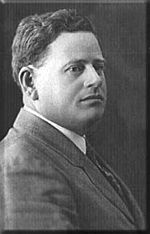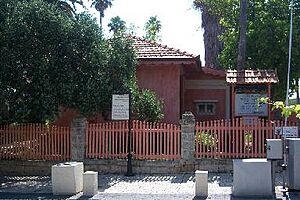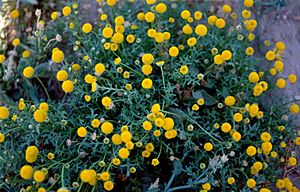Aaron Aaronsohn facts for kids
Quick facts for kids
Aaron Aaronsohn
|
|
|---|---|
 |
|
| Born | 21 May 1876 Bacău, Romania
|
| Died | 15 May 1919 (aged 42) The English Channel
|
| Relatives | Sarah Aaronsohn (sister) |
| Known for | Discoverer of emmer (Triticum dicoccoides) |
| Scientific career | |
| Fields | Botany, agronomy |
| Author abbrev. (botany) | Aarons. |
Aaron Aaronsohn (Hebrew: אהרון אהרנסון) (May 21, 1876 – May 15, 1919) was a smart Jewish scientist. He studied plants (a botanist) and farming (an agronomist). He was also a Zionist activist. Aaronsohn was born in Romania. He spent most of his life in the Land of Israel, which was then part of the Ottoman Empire. He is famous for finding a special type of wild wheat called emmer (Triticum dicoccoides). Many people call it "the mother of wheat." He also started and led a secret group called Nili.
Contents
Aaron Aaronsohn's Early Life
Aaron Aaronsohn was born in Bacău, Romania. When he was six, his family moved to Palestine. This land was then ruled by the Turkish Ottoman Empire. His parents helped start Zikhron Ya'akov. This was one of the first Jewish farming towns in the area. He had two sisters, Sarah and Rivka.
Aaronsohn was very modern for his time. He was the first person in Palestine to own a car. He also brought one of the first bicycles back from France. At home, he spoke Yiddish and Hebrew. He also knew English, Arabic, Turkish, French, German, and some Italian.
Discovering New Plants and Farming Methods
Aaronsohn studied farming in France. Baron Edmond de Rothschild helped pay for his studies. After returning, he worked in Metulla, a new farming community in northern Palestine. He later started a group to improve farming technology.
He worked with a member of the German Templer community. They started a business to bring in and sell modern farm machines. These included reapers and combine harvesters. He also sold gasoline-powered pumps and tools for making butter. He imported different kinds of seeds and grapevines too.
Aaronsohn carefully mapped the plants of Palestine. He became a top expert on the region's plant life. In 1906, he went on a trip to Mount Hermon. While exploring the Upper Galilee area, he made a huge discovery. He found Triticum dicoccoides, which he called the "mother of wheat." This was a very important find for scientists and historians.
Scientists have since shown that this wild emmer is indeed an ancestor of most wheat we grow today. This discovery made Aaronsohn famous around the world. He traveled to the United States and got money to open a research station. This station was built in Atlit in 1909. There, Aaronsohn collected many plant and rock samples. He also built a large library for his research.
In 1915, a huge swarm of desert locusts attacked the country. They destroyed almost all the plants. Aaronsohn helped Djemal Pasha fight this locust invasion. He and his team were allowed to travel freely. They made detailed maps of the areas they studied.
In 1918, Aaronsohn helped decide the northern border of Palestine. He focused on making sure there was enough water for farming. He wanted the border to include the sources of the Jordan, Litani, and Yarmuk rivers. His ideas became important for the Zionist plan presented in Paris in 1919.
Secret Work During World War I
During World War I, the Ottoman Empire joined forces with Germany. Aaronsohn worried that the Jewish people in Palestine would suffer. He feared they might face a terrible fate, like the Armenians. So, he decided to act.
He, his assistant Avshalom Feinberg, his sister Sarah Aaronsohn, and others formed a secret group called Nili. This group spied for Britain during the war. Aaronsohn suggested a plan for General Edmund Allenby to attack through Beersheba. This plan helped Allenby capture Jerusalem in December 1917. Nili gave the British Army information about water sources in the desert. This allowed General Allenby to surprise the Ottoman defenses in Gaza.
In 1917, Chaim Weizmann sent Aaronsohn to the USA for political work. While there, Aaronsohn learned bad news. The Ottoman authorities had caught a Nili messenger pigeon. This led to his sister Sarah and other group members being arrested. They faced very difficult times.
Aaron Aaronsohn's Legacy
After the war, Weizmann asked Aaronsohn to help with the Versailles Peace Conference. On May 15, 1919, Aaronsohn died in an airplane crash. This happened over the English Channel while he was flying to France. The exact reasons for the crash are still unclear.
Aaronsohn never married or had children. His important research on the plants of Palestine and Transjordan was published after his death. His exploration diaries were also published.
After Aaronsohn passed away, a British military intelligence leader confirmed something important. He said that General Allenby's victory would not have been possible without the information from Aaronsohn's group.
Published Works
- Agricultural and botanical explorations in Palestine, 1910
- "Shemot ha-tzemachim" ("Botanical names"), in: Hashelaḥ 26 (1912)
- Reliquiae Aaronsohnianae, 1940
See also
- Agricultural research in Israel
- Wildlife of Israel



